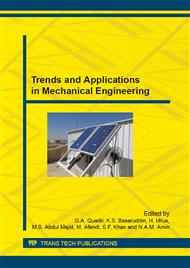p.181
p.188
p.193
p.199
p.205
p.210
p.215
p.220
p.226
Numerical Simulation for the Aerodynamics of Vertical Axis Wind Turbine with Two Different Rotors Having Movable Vanes
Abstract:
Wind energy has seen a rapid growth worldwide. Wind turbines are typical devices that convert the kinetic energy of wind into electricity. Researches in the past have proved that Vertical Axis Wind Turbines (VAWTs) are more suitable for urban areas than Horizontal Axis Wind Turbines (HAWTs). In the present design of the VAWT, the power prodused depends on the drag force generated by the individual blades and interactions between them in a rotating configuration. Numerical simulation for the aerodynamics of VAWT with tow different rotors (Three and Foure blades ) having movable vanes are curred out. The For numerical simulation, commercially available computational fluid dynamic (CFD) softwares GAMBIT and FLUENT are used. In this work the Shear Stress Transport (SST) k-ω turbulence model was used which is better than the other turbulence models available as suggested by some researchers. The predicted results show agreement with those reported in the literature for VAWT having different blades designs.
Info:
Periodical:
Pages:
205-209
Citation:
Online since:
August 2015
Authors:
Price:
Сopyright:
© 2015 Trans Tech Publications Ltd. All Rights Reserved
Share:
Citation:


